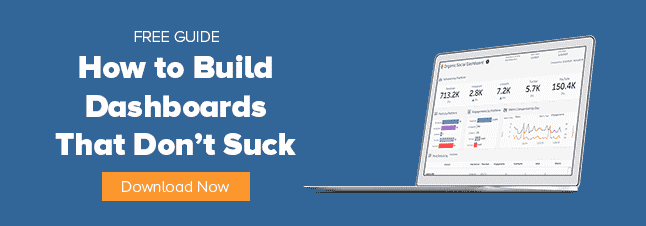
Want to instantly make your marketing analytics more useful and relevant? Stop reporting on vanity metrics.
A vanity metric is a number that looks impressive, but isn’t meaningful or actionable. You can’t use it to make better decisions about your marketing strategy. And making better decisions is the whole point of marketing analytics.
A lot of marketers like to include vanity metrics in their dashboards because, well, it makes them look good — and they need to look good if they want their boss or client to continue funding the marketing budget.
Of course, data is only valuable if it helps an organization reach a core goal, whether that means increasing revenue, limiting churn or some other bottom-line outcome.
Vanity metrics can’t help you with any of that — they are the junk food of marketing data. They’re tasty, and they might even make you feel full. But they have almost no nutritional value. Dine on them exclusively, and you’re going to be in bad shape.
How to Identify a Vanity Metric in 3 Steps
This is one of the most popular and easy-to-use tests for determining if a KPI is actually a vanity metric. Ask yourself:
- Does this metric help you make a decision? “We generated 1 million impressions last month!” Cool … but did that help us generate more leads or more sales? Is that number good? Without that context, you don’t know if you should spend more or less on this channel.
- Can you reproduce this metric, or is it a fluke? “Holy cow, we had 1 million sessions on the website last week.” Yeah, because our CEO has the same name as the winner of “America’s Got Talent” — it’s probably not going to happen again.
- Can you trust the data underlying this metric? “Our website sessions are up 30 percent this quarter.” Unfortunately, a sizable portion of that new traffic is from bots.
Examples of Vanity Metrics
Pageviews
Pageviews are a good example of a vanity metric because they’re usually a large number, but on their own, they don’t show you if your site’s visitors are getting any closer to making a purchase or completing a form fill. You would be better off tracking the number of goal completions on your website or your conversion rate.
Social Media Fans and Followers
In the world of social media, followers and fans usually count as vanity metrics because you don’t know if all those people are actively engaging with your content or buying your products. It would be more useful to see how many of your website sessions or conversions can be linked back to a social post.
What if you’re working with an influencer? It could be useful to know how many followers they have, but be cautious. Someone with 1 million unengaged (and possibly fake) followers isn’t as valuable as an influencer with a small, highly engaged, high-converting audience.
Subscribers and Users
A good rule of thumb? Cumulative metrics — which only go up — are usually vanity metrics. It looks impressive that 2 million people have downloaded your app since it launched. But your current number of active users is a better gauge of your audience size.
The same goes for newsletter subscribers. It doesn’t matter if you have an enormous list if only a tiny fraction of your subscribers are engaging with your content.
When a Vanity Metric Isn’t a Vanity Metric
It’s important to note that a vanity metric in one situation might actually be useful in another. It all depends on context.
(To continue our junk food analogy: If you haven’t eaten anything for a week, a dozen doughnuts might save your life.)
Impressions
Your CEO probably won’t care that your last campaign generated 3 million impressions if you can’t prove those impressions led to an increase in sales, revenue or market share.
But what if you’re a media buyer or a channel manager responsible for increasing brand awareness? Impression data can help you optimize where you invest your time and money.
Email Open Rate
In the world of email marketing, open rate sometimes gets tagged as a vanity metric.
It doesn’t matter how many people are opening your messages if they aren’t visiting your website and buying something, right? Ergo, click-through rate would be a better KPI.
That doesn’t mean open rates are completely worthless, though. If you need to test the effectiveness of your subject line, your open rate can give you useful insight.
CASE STUDY: Winning More Business with an ROI Dashboard
How to Avoid Vanity Metrics
You can prevent the use of vanity metrics by creating a measurement strategy for marketing data. Before you build a new dashboard or report, you should take the time to create this strategy first.
This blog post breaks down measurement strategy in depth, but it’s basically a plan that forces you to ask …
Who is your audience?
Someone in the C-suite is going to have different questions from someone who oversees your content marketing campaigns. Their reporting and their KPIs need to be tailored to their concerns.
What is your reporting frequency?
If you’re a channel manager, you probably want weekly or even daily reports so you can quickly optimize spend. But a CMO might want the bigger picture, like a report that covers an entire quarter’s worth of activity.
What does success look like?
Success metrics are usually totals — total number of website sessions, total number of leads, total number of sales, total number of revenue generated. Success metrics let you know if a marketing initiative has achieved its stated goals.
How can performance be improved?
These are optimization metrics that let you increase the efficiency and effectiveness of your marketing. Cost per click, cost per lead, cost per conversion — these are all good examples of optimization KPIs.
It’s also smart to track conversion rates between different stages in your funnel. If you know how many website sessions are required to generate a lead, or how many leads are required to generate one sale, you have a powerful tool for setting and hitting goals.
What data is required to answer those questions?
Once you understand what questions you’re trying to answer, it’s a lot easier to gather the necessary data — and only the necessary data — for your reporting and analysis. You can more easily avoid vanity metrics because you have a clear idea of what is and isn’t relevant to your audience.
Using a measurement strategy and removing vanity metrics from your marketing reports will ultimately make your marketing data more relevant and useful to your end users. While it takes a little thought, the time you spend here will pay off with a healthier view of marketing performance.
Need Help with Your Measurement Strategy?
Our team can help you create a measurement strategy that’s perfect for your data and your goals. Book a call today!

